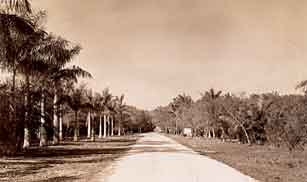

Entrance to Royal Palm State Park (site of Royal Palm Hammock) about 1934 - 35 . Road was built and Florida Federation of Women's Clubs gained land title in 1915.
Royal Palm Lodge c. 1930. It was built in Royal Palm Hammock 1916-1918. The Ingraham Highway, original road to Flamingo, is in foreground.
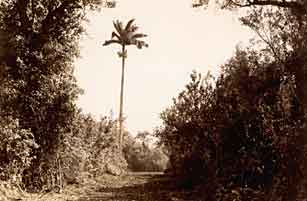

Path cut through Royal Palm Hammock by the Civilian Conservation Core. Photo c. 1934. Paths were just one of many projects they completed by June, 1934.
Royal Palm c. 1950, three years after it was taken over by Everglades National Park. Lodge driveway is on right just behind car in road.
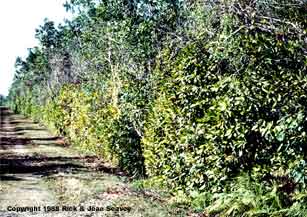
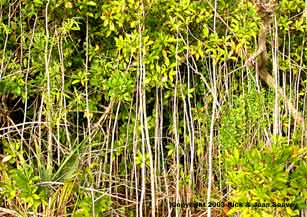
By 1985, long after Royal Palm Lodge, much of the hammock looked like the picture above with yellow-green exotic shoebutton ardisia thick in its understory.
Shoebutton ardisia grows, tightly packed in largely monotypic stands, on thin trunks. The ground is usually covered with seedlings excluding all natives.

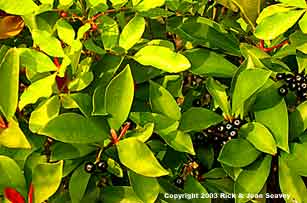
Shoebutton ardisia, Ardisia elliptica, tree usually reaches a height of 9 ft. Note the red flush of growth at the tree's tip. There is very little secondary branching.
Shoebutton ardisia leaves and fruit. Immature fruit is red (upper left) and ripens to black in November and December. It grows in the leaf axils.
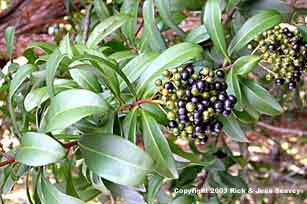
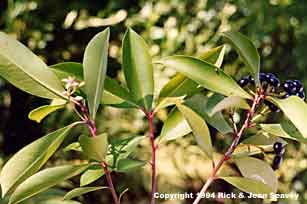
Marlberry, Ardisia escallonioides, is native. It differs from our exotic by having a cinnamon brown stem and leaf stalk. Its fruit is terminal instead of axillary.
Shoebutton ardisia leaves have obscure veining and midrib. Stems and leaf stalks are bright pink, unlike marlberry. Seeds remain viable in soil for one year.
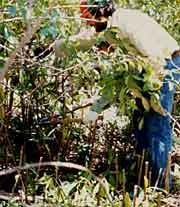
Cutting shoebutton ardisia in Royal Palm Hammock. Treatment involved cutting the trunk with lopping shears horizontal and as low to the ground as possible. A flat cut surface was necessary to hold the herbicide until fully absorbed.

Hauling away cut trees; removing all cut material so stumps were clear for herbicide application. Before cutting trees (to avoid herbicide contact ), hundreds of volunteers pulled seedlings and placed them in large plastic bags. Set transects enabled thorough coverage and less overwhelming work.
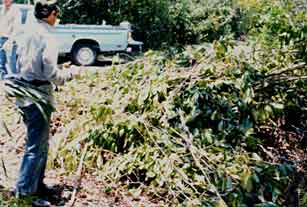
Pile of cut trees (left). Herbicided stumps (right). Stumps were treated with Garlon 3A applied with a small squirt bottle which was dabbed on the stump's flat cut surface. Treatment was very effective with no contamination to the environment. Note the lack of native vegetation around the stumps.
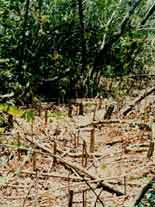


Hammock edge before ardisia removal. This exotic dominates the understory. Nothing else grows there.
Hammock 14 years after ardisia removal. Seedlings were weeded again the year after tree removal.
Hammocks (islands of hardwood trees, with shade, disturbed soil and humidity due to a closed canopy) provide optimal conditions for ardisia elliptica. It was found in 9 ENP hammocks in both disturbed and undisturbed soil conditions. Due to disturbance history and proximity to a seed source Royal Palm was the most heavily impacted. 14 years later, it is still reasonably free of this exotic but ardisia is beginning to reappear here and in other former haunts. We hope the Park Service will remember our work and not let shoebutton ardisia ever regain a foothold in its precious hammocks.
P.S. Gwen Burzcycki, Miami-Dade Dept. of Environmental.
Resources Management, recently told me that the state exotic plant removal
contractor was unaware of our successful method of ardisia treatment.
She is in the process of creating controlled experiments to narrow down
optimal treatment procedure for him. We were definitely ahead of the
times with this project!
Although we did present the work to the Technical Advisory Group on
Biological Control of Weeds on 7-20-95 and later to the Florida Exotic Pest
Pant Council at their annual meeting, it was never published. (The
Cape Sable project was also presented in a field trip at this FLEPPC
conference.)